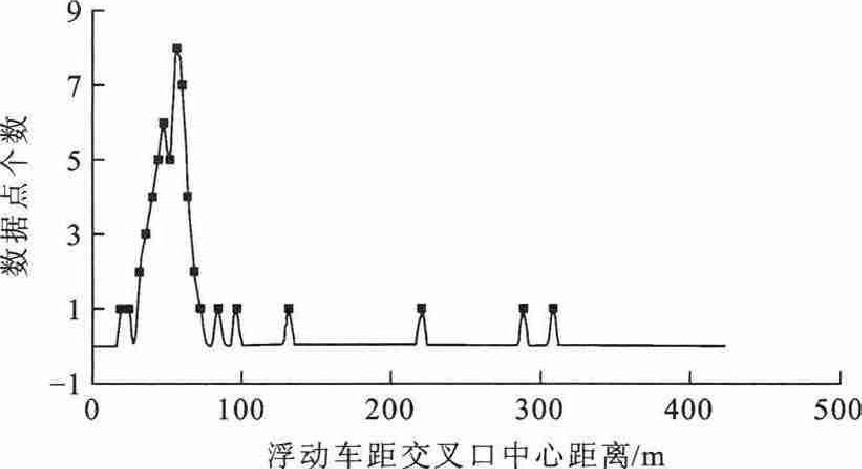Mining method of floating car data based on link travel time estimation
-
摘要: 基于浮动车数据, 提出一种信号配时信息缺失下的路段行程时间估计方法, 由交叉口范围动态划分、路段影响范围划分、浮动车数据提取与路段行程时间估计4个模块组成, 每个模块的实现均需借助于前一模块的输出。根据交叉口信号控制下的车辆行驶状态, 在交叉口范围动态划分与路段影响范围划分2个模块中, 利用密度法将单元路段划分为不同区域。根据路段行程时间估计原理, 利用浮动车数据提取模块过滤掉受信号控制影响较大的浮动车数据, 提取路段行程时间估计的目标数据。利用路段行程时间估计模块挖掘历史浮动车数据, 根据浮动车目标数据点存在区域的不同, 将浮动车数据分为3类, 并对不同类型数据采取相应的断面通过时刻估计方法, 建立基于不同数据条件下的行程时间估计模型。利用VISSIM软件对路段行程时间估计方法进行仿真验证, 并与直接法和间接法进行对比分析。分析结果表明: 对于粗粒度浮动车数据, 路段行程时间估计方法的平均绝对误差和平均相对误差分别为12 s和8.67%, 优于传统的直接法与间接法。Abstract: Based on floating car data, a link travel time estimation method without signal timing data was proposed.The method consisted of four modules, which were intersection boundary dynamic partition module, link influence range partition module, floating car data extraction module, and link travel time estimation module, and the implementation of each module relied greatly on the output of previous one.According to vehicle travel state under the influence of signal control, link unit was divided into different segments by using density method in intersection boundary dynamic partition module and link influence range partition module.According to link travel time estimation mechanism, floating car data that were seriously affected by signal control were filtered off in floating car data extraction module, so the target floating car data could be obtained.Historical floating car data were excavated in link travel time estimation module, and floating car data were divided into 3 types according to different exsited regions of target data.Corresponding section travel time estimation methods were used for different types of data, and corresponding section travel time estimation models were established.Link travel time estimation method was simulated and verified by using software VISSIM, and its result was compared with the results of direct and indirect methods.Analysis result indicates that for coarse-grained floating car data, the average absolute error and average relative error of link travel time estimation method are 12 sand 8.67% respectively, so it performs better than traditional direct and indirect methods.
-
表 1 子状态属性
Table 1. Sub-state properties

表 2 目标交叉口的信息配时方案
Table 2. Signal timing plan of target intersection

表 3 路段行程时间
Table 3. Link travel times
s 
-
[1] WANG Jian-qiang, NIU Hui-min. Graded-information feedback strategy in two-route systems under ATIS[J]. Journal of Traffic and Transportation Engineering: English Edition, 2014, 1 (2): 138-145. doi: 10.1016/S2095-7564(15)30098-2 [2] WU C H, HO J M, LEE D T. Travel time prediction with support vector regression[J]. IEEE Transactions on Intelligent Transportation Systems, 2004, 5 (4): 276-281. doi: 10.1109/TITS.2004.837813 [3] SUN Lu, YANG Jun, MAHMASSANI H. Travel time estimation based on piecewise truncated quadratic speed trajectory[J]. Transportation Research Part A: Policy and Practice, 2008, 42 (1): 173-186. doi: 10.1016/j.tra.2007.08.004 [4] ZHENG Fang-fang, ZUYLEN H. Comparison of urban link travel time estimation models based on probe vehicle data[C]∥MAO Bao-hua, TIAN Zong-zhong, HUANG Hai-jun, et al. Seventh International Conference on Traffic and Transportation Studies. Kunming: ASCE, 2010: 615-626. [5] ZHENG Fang-fang, ZUYLEN H. Urban link travel time estimation based on sparse probe vehicle data[J]. Transportation Research Part C: Emerging Technologies, 2013, 31 (1): 145-157. https://www.sciencedirect.com/science/article/pii/S0968090X12000575 [6] BI Song, WANG Zhi-jian, HAN Cun-wu, et al. Estimation of left-turning travel time at traffic intersection[J]. The Journal of China Universities of Posts and Telecommunications, 2013, 20 (S1): 10-14. https://www.sciencedirect.com/science/article/pii/S1005888513602575 [7] HAN Shu, LIN Hang-fei, CHEN Xiao-hong. The application of link aggregating algorithm in travel time estimate on signalized arterial network[C]∥PENG Qi-yuan, WANG K C P, QIU Yan-jun, et al. Second International Conference on Transportation Engineering. Chengdu: ASCE, 2009: 2315-2321. [8] JIANG Zhou, ZHANG Cun-bao, XIA Yin-xia. Travel time prediction model for urban road network based on multisource data[J]. Procedia-Social and Behavioral Sciences, 2014, 138: 811-818. doi: 10.1016/j.sbspro.2014.07.230 [9] 李进燕, 朱征宇, 刘琳, 等. 基于简化路网模型的卡尔曼滤波多步行程时间预测方法[J]. 系统工程理论与实践, 2013, 33 (5): 1289-1297. doi: 10.3969/j.issn.1000-6788.2013.05.026LI Jin-yan, ZHU Zheng-yu, LIU Lin, et al. Multi-step Kalman filtering travel time estimation method based on simplified road network model[J]. Systems Engineering—Theory and Practice, 2013, 33 (5): 1289-1297. (in Chinese). doi: 10.3969/j.issn.1000-6788.2013.05.026 [10] ZHENG Fang-fang, WAN Yu, WU Ping-heng. Link traveltime prediction using extended exponential smoothing and Kalman filter in dynamic networks[C]∥LIU Rong-fang, ZHANG Jin, GUAN Chang-qian. The Eighth International Conference of Chinese Logistics and Transportation Professionals. Chengdu: ASCE, 2008: 3753-3759. [11] LIU H X, MA Wen-teng. A virtual vehicle probe model for time-dependent travel time estimation on signalized arterials[J]. Transportation Research Part C: Emerging Technologies, 2009, 17 (1): 11-26. doi: 10.1016/j.trc.2008.05.002 [12] JENELIUS E, KOUTSOPOULOS H N. Travel time estimation for urban road networks using low frequency probe vehicle data[J]. Transportation Research Part B: Methodological, 2013, 53: 64-81. doi: 10.1016/j.trb.2013.03.008 [13] 李嘉, 刘春华, 胡赛阳, 等. 基于交通数据融合技术的行程时间预测模型[J]. 湖南大学学报: 自然科学版, 2014, 41 (1): 33-38. https://www.cnki.com.cn/Article/CJFDTOTAL-HNDX201401006.htmLI Jia, LIU Chun-hua, HU Sai-yang, et al. A travel time prediction model based on traffic data fusion technology[J]. Journal of Hunan University: Natural Sciences, 2014, 41 (1): 33-38. (in Chinese). https://www.cnki.com.cn/Article/CJFDTOTAL-HNDX201401006.htm [14] 方路平, 陈仕骁, 赵飞帆. 基于小样本浮动车系统的平均行程时间估计[J]. 计算机仿真, 2012, 29 (9): 367-370. doi: 10.3969/j.issn.1006-9348.2012.09.091FANG Lu-ping, CHEN Shi-xiao, ZHAO Fei-fan. Average link travel time estimation based on floating car of small sample size[J]. Computer Simulation, 2012, 29 (9): 367-370. (in Chinese). doi: 10.3969/j.issn.1006-9348.2012.09.091 [15] 姜桂艳, 常安德, 张玮. 基于GPS浮动车的路段行程时间估计方法比较[J]. 吉林大学学报: 工学版, 2009, 39 (增2): 182-186. https://www.cnki.com.cn/Article/CJFDTOTAL-JLGY2009S2039.htmJIANG Gui-yan, CHANG An-de, ZHANG Wei. Comparison of link travel-time estimation methods based on GPS equipped floating car[J]. Journal of Jilin University: Engineering and Technology Edition, 2009, 39 (S2): 182-186. (in Chinese). https://www.cnki.com.cn/Article/CJFDTOTAL-JLGY2009S2039.htm [16] 姜桂艳, 常安德, 张玮, 等. 基于GPS浮动车的自然路段行程时间估计方法[J]. 公路, 2009 (11): 87-90. https://www.cnki.com.cn/Article/CJFDTOTAL-GLGL200911019.htmJIANG Gui-yan, CHANG An-de, ZHANG Wei. Physical link travel-time estimation method based on GPS equipped floating car[J]. Highway, 2009 (11): 87-90. (in Chinese). https://www.cnki.com.cn/Article/CJFDTOTAL-GLGL200911019.htm [17] 姜桂艳, 常安德, 吴超腾. 基于GPS浮动车的交通信息采集方法[J]. 吉林大学学报: 工学版, 2010, 40 (4): 971-975. https://www.cnki.com.cn/Article/CJFDTOTAL-JLGY201004017.htmJIANG Gui-yan, CHANG An-de, WU Chao-teng. Traffic information collection method based on GPS equipped floating car[J]. Journal of Jilin University: Engineering and Technology Edition, 2010, 40 (4): 971-975. (in Chinese). https://www.cnki.com.cn/Article/CJFDTOTAL-JLGY201004017.htm [18] 韩舒, 林航飞, 辛飞飞. 浮动车采集系统中城市道路分段方法研究[J]. 交通与计算机, 2007, 25 (5): 105-109. https://www.cnki.com.cn/Article/CJFDTOTAL-JTJS200705031.htmHAN Shu, LIN Hang-fei, XIN Fei-fei. Method of merging urban road subsections based on floating car data[J]. Computer and Communications, 2007, 25 (5): 105-109. (in Chinese). https://www.cnki.com.cn/Article/CJFDTOTAL-JTJS200705031.htm [19] 熊英格, 徐卓立, 刘好德. 基于浮动车数据的交叉口范围动态划分方法[J]. 交通信息与安全, 2009, 27 (5): 38-43. https://www.cnki.com.cn/Article/CJFDTOTAL-JTJS200905010.htmXIONG Ying-ge, XU Zhuo-li, LIU Hao-de. Methods of intersection dynamic subsections based on floating car data[J]. Journal of Transport Information and Safety, 2009, 27 (5): 38-43. (in Chinese). https://www.cnki.com.cn/Article/CJFDTOTAL-JTJS200905010.htm [20] 胡小文. 基于探测车数据和固定检测器数据的路段行程时间估计[D]. 上海: 同济大学, 2008.HU Xiao-wen. Link travel time estimation based on probe data and fixed detector data[D]. Shanghai: Tongji University, 2008. (in Chinese). -





 下载:
下载:























